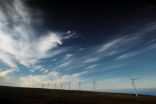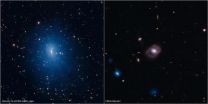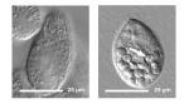(Press-News.org) CAMBRIDGE, Mass. -- The must-have gift for young female chimpanzees this holiday season might be in the Christmas tree, not under it.
That's the finding of scientists at Harvard University and Bates College, who say female chimpanzees appear to treat sticks as dolls, carrying them around until they have offspring of their own. Young males engage in such behavior much less frequently.
The new work by Sonya M. Kahlenberg and Richard W. Wrangham, described this week in the journal Current Biology, provides the first suggestive evidence of a wild non-human species playing with rudimentary dolls, as well as the first known sex difference in a wild animal's choice of playthings.
The two researchers say their work adds to a growing body of evidence that human children are probably born with their own ideas of how they want to behave, rather than simply mirroring other girls who play with dolls and boys who play with trucks. Doll play among humans could have its origins in object-carrying by earlier apes, they say, suggesting that toy selection is probably not due entirely to socialization.
"In humans, there are robust sex differences in children's toy play, and these are remarkably similar across cultures," says Kahlenberg, a lecturer in biology at Bates who conducted the research as a postdoctoral researcher in Wrangham's group at Harvard. "While socialization by elders and peers has been the primary explanation, our work suggests that biology may also have an important role to play in activity preferences."
In 14 years of data on chimpanzee behavior at the Kibale National Park in Uganda, Kahlenberg and Wrangham counted more than 100 examples of stick-carrying. In many cases young females weren't using the sticks for foraging or fighting, as adults sometimes do, or for any other discernable purpose.
Some young chimpanzees carried sticks into the nest to sleep with them and on one occasion built a separate nest for the stick. The researchers even witnessed the animals playing a version of the "airplane game," lying on their backs with their "offspring" balanced across their upraised hands.
"We have seen juveniles occasionally carrying sticks for many years, and because they sometimes treated them rather like dolls, we wanted to know if in general this behavior tended to represent something like playing with dolls," says Wrangham, the Ruth Moore Professor of Biological Anthropology at Harvard. "If the doll hypothesis was right we thought that females should carry sticks more than males do, and that the chimpanzees should stop carrying sticks when they had their first offspring. We have now watched enough young chimpanzees to test both points."
Kahlenberg and Wrangham's observations included a few adult females carrying sticks, but only before they became mothers for the first time. Their finding clearly links juvenile play to adult behavior, since female chimpanzees, not males, carry infants more than 99 percent of the time.
"Obviously in humans there is a huge role for peers, parents, and others to influence a child's preferences for different kinds of toys, and the same may well be true of chimpanzees," Wrangham says. "One of the things that makes our finding fascinating is that there is little evidence of anything comparable in other chimpanzee communities, which raises the possibility that the chimpanzees are copying a local behavioral tradition. So this may be a lovely case of biological and social influences being intertwined."
INFORMATION:
Kahlenberg and Wrangham's research was supported by the National Science Foundation, the Leakey Foundation, the National Geographic Society, the Getty Foundation, and the Wenner-Gren Foundation.
Young female chimpanzees appear to treat sticks as dolls
Finding adds to growing evidence of a biological basis for gender-specific play in humans
2010-12-21
ELSE PRESS RELEASES FROM THIS DATE:
Outsmarting the wind
2010-12-21
RICHLAND, Wash. – Meteorological equipment typically used to monitor storms could help power grid operators know when to expect winds that will send turbine blades spinning, as well as help them avoid the sudden stress that spinning turbines could put on the electrical grid.
"We know that the wind will blow, but the real challenge is to know when and how much," said atmospheric scientist Larry Berg. "This project takes an interesting approach –adapting an established technology for a new use – to find a reliable way to measure winds and improve wind power forecasts."
Berg ...
CCNY-led interdisciplinary team recreates colonial hydrology
2010-12-21
Hydrologists may have a new way to study historical water conditions. By synthesizing present-day data with historical records they may be able to recreate broad hydrologic trends on a regional basis for periods from which scant data is available.
Lack of reliable historical data can impede hydrologists' understanding of the current state of waterways and their ability to make predictions about the future. That was the case for the rivers of the northeastern United States between 1600 and 1800, a period that runs from just before the first European settlers arrived ...
What makes a face look alive? Study says it's in the eyes
2010-12-21
The face of a doll is clearly not human; the face of a human clearly is. Telling the difference allows us to pay attention to faces that belong to living things, which are capable of interacting with us. But where is the line at which a face appears to be alive? A new study published in Psychological Science, a journal of the Association for Psychological Science, finds that a face has to be quite similar to a human face in order to appear alive, and that the cues are mainly in the eyes.
Several movies have tried and failed to generate lifelike animations of humans. ...
Globalization burdens future generations with biological invasions
2010-12-21
A new study on biological invasions based on extensive data of alien species from 10 taxonomic groups and 28 European countries has shown that patterns of established alien species richness are more related to historical levels of socio-economic drivers than to contemporary ones. An international group of 16 researchers reported the new finding this week in the Proceedings of the National Academy of Sciences of the United States of America (PNAS). The publication resulted from the three-year project DAISIE (Delivering Alien Invasive Inventory for Europe, www.europe-aliens.org), ...
New report finds Cambodia's HIV/AIDS fight at critical crossroads in funding, prevention
2010-12-21
Phnom Penh, Cambodia (21 December, 2010) – Despite Cambodia's remarkable history in driving down HIV infections, a report released today on the future of AIDS in the country argues that future success is not guaranteed and the government needs to focus increasingly on wise prevention tactics and assume more of the financing of its AIDS program.
The report, called The Long-Run Costs and Financing of HIV/AIDS in Cambodia, written by Cambodian experts working closely with staff of the Results for Development Institute (R4D), based in Washington, D.C., finds that Cambodia, ...
How often do giant black holes become hyperactive?
2010-12-21
A new study from NASA's Chandra X-ray Observatory tells scientists how often the biggest black holes have been active over the last few billion years. This discovery clarifies how supermassive black holes grow and could have implications for how the giant black hole at the center of the Milky Way will behave in the future.
Most galaxies, including our own, are thought to contain supermassive black holes at their centers, with masses ranging from millions to billions of times the mass of the Sun. For reasons not entirely understood, astronomers have found that these ...
New study upends thinking about how liver disease develops
2010-12-21
In the latest of a series of related papers, researchers at the University of California, San Diego School of Medicine, with colleagues in Austria and elsewhere, present a new and more definitive explanation of how fibrotic cells form, multiply and eventually destroy the human liver, resulting in cirrhosis. In doing so, the findings upend the standing of a long-presumed marker for multiple fibrotic diseases and reveal the existence of a previously unknown kind of inflammatory white blood cell.
The results are published in this week's early online edition of the Proceedings ...
UCSB scientists demonstrate biomagnification of nanomaterials in simple food chain
2010-12-21
(Santa Barbara, Calif.) –– An interdisciplinary team of researchers at UC Santa Barbara has produced a groundbreaking study of how nanoparticles are able to biomagnify in a simple microbial food chain.
"This was a simple scientific curiosity," said Patricia Holden, professor in UCSB's Bren School of Environmental Science & Management and the corresponding author of the study, published in an early online edition of the journal Nature Nanotechnology. "But it is also of great importance to this new field of looking at the interface of nanotechnology and the environment."
Holden's ...
New imaging advance illuminates immune response in breathing lung
2010-12-21
Fast-moving objects create blurry images in photography, and the same challenge exists when scientists observe cellular interactions within tissues constantly in motion, such as the breathing lung. In a recent UCSF-led study in mice, researchers developed a method to stabilize living lung tissue for imaging without disrupting the normal function of the organ. The method allowed the team to observe, for the first time, both the live interaction of living cells in the context of their environment and the unfolding of events in the immune response to lung injury.
The finding ...
Strange new twist: Berkeley researchers discover Möbius symmetry in metamaterials
2010-12-21
Möbius symmetry, the topological phenomenon that yields a
half-twisted strip with two surfaces but only one side, has been a source of fascination since its discovery in 1858 by German mathematician August Möbius. As artist M.C. Escher so vividly demonstrated in his "parade of ants," it is possible to traverse the "inside" and "outside" surfaces of a Möbius strip without crossing over an edge. For years, scientists have been searching for an example of Möbius symmetry in natural materials without any success. Now a team of scientists has discovered Möbius symmetry in ...
LAST 30 PRESS RELEASES:
Support for parents with infants at pediatric check-ups leads to better reading and math skills in elementary school
Kids’ behavioral health is a growing share of family health costs
Day & night: Cancer disrupts the brain’s natural rhythm
COVID-19 vaccination significantly reduces risk to pregnant women and baby
The role of vaccination in maternal and perinatal outcomes associated with COVID-19 in pregnancy
Mayo Clinic smartwatch system helps parents shorten and defuse children's severe tantrums early
Behavioral health spending spikes to 40% of all children’s health expenditures, nearly doubling in a decade
Digital cognitive behavioral treatment for generalized anxiety disorder
Expenditures for pediatric behavioral health care over time and estimated family financial burden
Air conditioning in nursing homes and mortality during extreme heat
The Alps to lose a record number of glaciers in the next decade
What makes a good proton conductor?
New science reporting guide published for journalists in Bulgaria
New international study reveals major survival gaps among children with cancer
New science reporting guide published for journalists in Turkey
Scientists develop a smarter mRNA therapy that knows which cells to target
Neuroanatomy-informed brain–machine hybrid intelligence for robust acoustic target detection
Eight SwRI hydrogen projects funded by ENERGYWERX
The Lundquist Institute and its start-up company Vitalex Biosciences Announces Strategic Advancement of Second-Generation fungal Vaccine VXV-01 through Phase 1 Trials under $40 Million Competitive Con
Fine particles in pollution are associated with early signs of autoimmune disease
Review article | Towards a Global Ground-Based Earth Observatory (GGBEO): Leveraging existing systems and networks
Penn and UMich create world’s smallest programmable, autonomous robots
Cleveland researchers launch first major study to address ‘hidden performance killer’ in athletes
To connect across politics, try saying what you oppose
Modulating key interaction prevents virus from entering cells
Project explores barriers to NHS career progression facing international medical graduates
Jeonbuk National University researchers explore the impact of different seasonings on the flavor perception of Doenjang soup
Two Keck Medicine of USC Hospitals named Leapfrog Top Teaching Hospitals
World-first discovery uncovers how glioblastoma tumours dodge chemotherapy, potentially opening the door to new treatments
A fatal mix-up: How certain gut bacteria drive multiple sclerosis
[Press-News.org] Young female chimpanzees appear to treat sticks as dollsFinding adds to growing evidence of a biological basis for gender-specific play in humans





